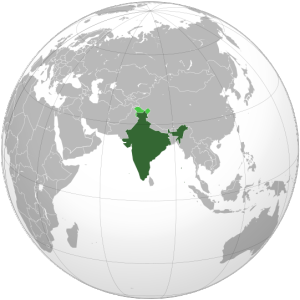Global warming has significant impacts on India, affecting various aspects of the country’s environment, economy, and society.
In recent years, India has witnessed a notable surge in the frequency and intensity of extreme weather conditions, primarily attributed to global warming and climate change. Among the most devastating occurrences are intense rainfall, flash floods, heatwaves, and cyclones. The rising global temperatures elevate the rates of evaporation, which in turn contributes to more pronounced instances of heavy rainfall.

What is Global Warming?
 Global warming is defined as an increase in the average temperature of the Earth’s atmosphere, especially a sustained increase significant enough to cause changes in the global climate. The term global warming is synonymous with an enhanced greenhouse effect, implying an increase in the amount of greenhouse gases in the earth’s atmosphere, leading to entrapment of more and more solar radiations, and thus increasing the overall temperature of the earth.
Global warming is defined as an increase in the average temperature of the Earth’s atmosphere, especially a sustained increase significant enough to cause changes in the global climate. The term global warming is synonymous with an enhanced greenhouse effect, implying an increase in the amount of greenhouse gases in the earth’s atmosphere, leading to entrapment of more and more solar radiations, and thus increasing the overall temperature of the earth.
An introduction to the profile of India:
India is the second most populous country of the world with a population over 1.2 billion. India lies to the north of the equator between 6° 44′ and 35° 30′ north latitude and 68° 7′ and 97° 25′ east longitude. It shares a coastline of 7517 km with the Indian Ocean, the Arabian Sea and the Bay of Bengal. It has land boundaries with Pakistan, China, Nepal, Bhutan, Burma and Bangladesh.
1. Temperature Rise and Heatwaves:
One of the most noticeable impacts of global warming on India is the rise in temperatures. The country has experienced an increase in average temperatures over the years, leading to more frequent and intense heatwaves. These heatwaves have adverse effects on public health, agriculture, and water resources. High temperatures can also exacerbate air pollution problems in urban areas.
2. Erratic Monsoons and Droughts:
Global warming has disrupted the traditional patterns of the monsoon season in India. Changes in temperature and weather patterns have led to erratic monsoons, resulting in both droughts and floods. Droughts have severe implications for agriculture, which is a significant source of livelihood for a large portion of the Indian population. Water scarcity becomes a critical issue during prolonged dry spells, impacting both rural and urban communities.
3. Sea Level Rise and Coastal Vulnerability:
Rising global temperatures contribute to the melting of polar ice caps and glaciers, leading to sea level rise. This phenomenon poses a significant threat to India’s extensive coastline, with densely populated areas at risk of inundation. Coastal erosion and saltwater intrusion also affect agricultural lands and freshwater sources in these regions.
4. Impact on Agriculture:
The agricultural sector in India is particularly vulnerable to the effects of global warming. Changes in temperature and precipitation patterns can disrupt crop cycles, reduce yields, and lead to food insecurity. Additionally, extreme weather events such as cyclones and heavy rainfall can cause widespread damage to crop and infrastructure.
5. Health Implications:
The impact of global warming on public health in India is substantial. Heat-related illnesses become more prevalent during prolonged heatwaves, affecting vulnerable populations such as the elderly and children. Furthermore, changes in climate patterns can influence the spread of vector-borne diseases like malaria and dengue fever.
6. Economic Consequences:
The economic repercussions of global warming are far-reaching for India. Disruptions in agriculture, infrastructure damage from extreme weather events, and increased healthcare costs all contribute to economic strain. Moreover, industries such as tourism and fisheries face challenges due to environmental degradation caused by rising temperatures.
7. Adaptation and Mitigation Efforts:
In response to these challenges, India has been actively engaged in efforts to adapt to and mitigate the impacts of global warming. The country has implemented various policies and initiatives focused on renewable energy development, afforestation programs, climate-resilient agriculture practices, and disaster preparedness measures.
* Recent Disaster
Recent heavy rainfall events in regions such as Uttarakhand and Himachal Pradesh have led to flash flooding and landslides, providing unequivocal evidence of the far-reaching impacts of this phenomenon. Particularly noteworthy is the unprecedented rise in the Yamuna River’s water level in Delhi, reaching a 45-year high due to unusually heavy rainfall during the second and third weeks of July this year.
The shifting precipitation patterns, coupled with higher evaporation rates, also significantly contribute to the growing frequency of droughts, which in turn bear severe implications for both food security and water resources.
In conclusion, global warming has multifaceted impacts on India, affecting diverse sectors including agriculture, public health, coastal areas, and the economy. Addressing these challenges requires concerted efforts at both national and international levels to mitigate greenhouse gas emissions and implement adaptation strategies.


